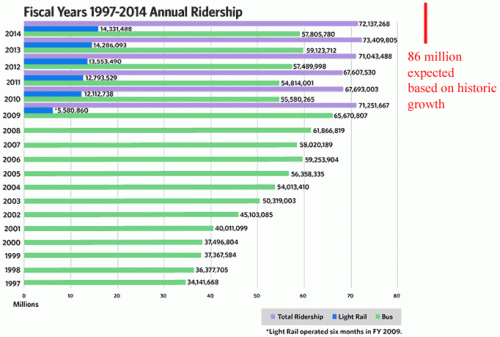Another Phoenix Light Rail Fail: Light Rail KILLS Transit Systems
Well, another year's ridership numbers are out for Valley Metro and Phoenix light rail and they are just as grim as they have been every year since Phoenix spent the first $1.4 billion on the first leg of the rail system (source)
Now, this picture is bad enough, until you realize that Valley Metro completed a huge extension of the rail line in 2016. In 2016 the line length was increased by 31% and the cumulative capital investment increased by 36%. With, as you can see, essentially zero effect on rail ridership in red. The only small highlight was that after falling for years, bus ridership actually perked up a few percent. As you may remember from earlier posts, bus ridership could be expected to fall due to cannibalization from light rail, but in fact it tends to fall even faster than rail ridership rises, causing total ridership to fall. The reason is that light rail costs at least an order of magnitude more (including amortized capex) per passenger mile than busses, and so light rail tends to starve the bus system of funds. Every light rail system implementation has been met with the need to slash bus service to pay for the huge light rail costs. So despite enormous operating subsidies and more than $2 billion in cumulative capex, rail ridership has been flat and total transit ridership has fallen.
But in fact the picture is worse than this when you look over a longer timeframe, which is why Valley Metro has probably changed their practice from graphing nearly 20 years of history to graphing just 6. Here is an older chart of theirs I posted years ago: (the top year in this chart is the bottom year in the chart above)
I will get back to the annotation in a moment. But notice that despite all the cost and disruption and higher taxes from the light rail system, total ridership this year of 66.8 million is less than any year since light rail was opened and baredly 8% higher than it was before light rail opened 10 years ago in 2008. Just organic city growth and recovery of the economy since 2008 should have driven faster growth than this. In fact, in the 10 years before light rail was opened, Phoenix transit ridership grew 70%. If that organic growth rate in bus service had been allowed to continue without the backbreaking costs and limited capacity of light rail being added to the mix, we should have expected 105 million riders this past year, not 66.8 million.

